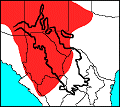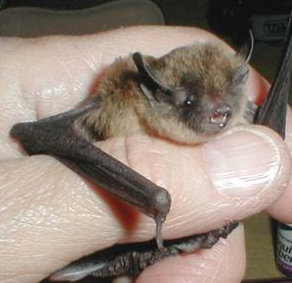


Myotis volans. U.S. National Park Service photograph.
Over much of their range, these long-legged bats are forest inhabitants preferring high, open woods and mountainous terrain, although they may also be found in a seasonal habitat along desert streams (Tuttle 2003). Nursery colonies, which may contain several hundred mothers, form in summer in places such as buildings, cliff crevices, and hollow trees. It appears that these bats do not roost in caves during the daytime; however they may use such sites at night (Davis and Schmidly 1994). The winter range and habits of this bat are not known, they "seem to simply disappear in winter" (Tuttle 2003:53). "Within Texas, this bat is known only by the collections from the Trans-Pecos (from the Guadalupe, Davis, Chinati, and Chiso mountains, and the Sierra Vieja)", where it appears to be rare, summer-time only resident (Schmidly 1977:41).
Davis, W. B., and D. J. Schmidly. 1994. The mammals of Texas. Texas Parks and Wildlife Press, Austin.
Schmidly, D. J. 1977. The mammals of Trans-Pecos Texas including Big Bend National Park and Guadalupe Mountains National Park. Texas A&M University Press, College Station.
Tuttle, M. D. (2003). Texas bats. Bat Conservation International, Inc., Austin.
A. Ruth Huckaby, Graduate Student, BIOL 5301—Natural History of the Chihuahuan Desert, June, 2006.
Huckaby Update: 22 June 2006
Last Update: 24 Jul 2009